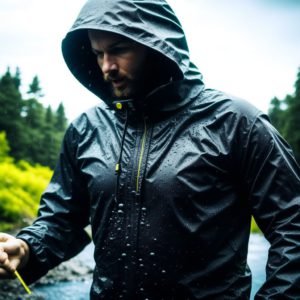Discover the Science Behind Layered Cold Weather Clothing for Ultimate Warmth and Style
Brrr! The chill of winter has arrived, and with it comes the challenge of maintaining both warmth and style in our attire. As temperatures drop, we instinctively layer our clothing in an attempt to shield ourselves from the cold. However, have you ever considered why certain layering techniques provide better protection than others? Today, we’re diving deep into the science of cold-weather clothing layering, exploring the principles that make some garments more effective in combating the winter chill than others.
Layering your clothing is not just a fashion choice; it’s a strategic approach to heat retention and comfort in cold conditions. When temperatures plummet, our bodies instinctively respond by constricting blood vessels to conserve heat, which can lead to cold extremities. Yet, our natural defenses may not always be sufficient. This is where the art and science of layering come into play, allowing us to create an effective barrier against the cold while maintaining mobility and comfort.

Establishing Your Base Layer: The Essential Foundation for Warmth
The base layer is the cornerstone of your cold-weather wardrobe, designed to fit snugly against your skin and provide essential insulation. To fully appreciate the significance of this layer, we must explore the science of moisture management and how it plays a pivotal role in keeping you warm and comfortable throughout the winter months.
Mastering Moisture-Wicking Fabrics for Optimal Comfort
Choosing the right material for your base layer is crucial for effective moisture management. The importance of moisture-wicking properties cannot be overstated. These fabrics are engineered to draw moisture away from your skin—whether from sweat or external sources—preventing it from lingering and causing discomfort. A high-quality base layer acts as a moisture barrier, ensuring you remain dry and comfortable even in adverse weather, thus enhancing your overall warmth.
Understanding Insulation: The Benefits of Merino Wool and Synthetic Fabrics
Now, let’s delve into how materials such as merino wool and synthetic fibers contribute to the insulating effectiveness of the base layer. Merino wool is renowned for its natural warmth and breathability, making it an excellent choice as it not only provides insulation but also effectively wicks moisture. On the other hand, synthetic materials like polyester and nylon strike a perfect balance between durability and insulation, creating a cozy microclimate next to your skin that efficiently retains body heat, keeping you warm even in harsh environments.
Achieving the Ideal Fit: Tips for Optimal Base Layer Performance
Selecting the right fit for your base layer involves more than just choosing your typical size; it’s about optimizing its performance. A close-fitting base layer maintains direct contact with your skin, enhancing both its insulating and moisture-wicking properties. However, achieving the perfect balance is vital—too tight can compromise comfort, while too loose may hinder effective performance. When determining fit, consider the type of activity and your overall layering strategy, ensuring seamless integration with your other cold-weather garments.
In summary, the first layer goes beyond simply adding extra clothing; it serves as a sophisticated moisture-wicking and insulating shield against the frigid winter air. By understanding the unique properties of materials like merino wool and synthetic fibers, along with mastering fit, you elevate your base layer from mere clothing to an essential component of your defense against the cold.
Maximizing Warmth with the Insulating Layer: Your Defense Against the Chill
 As we transition to the second layer, known as the insulating layer, we focus on its vital role in trapping and retaining warmth around your body. This layer is essential in the science of heat retention, acting as a protective cocoon against the harsh cold. Let’s delve into critical elements such as warmth-to-weight ratios, the advantages of down insulation, and the eco-conscious appeal of synthetic alternatives.
As we transition to the second layer, known as the insulating layer, we focus on its vital role in trapping and retaining warmth around your body. This layer is essential in the science of heat retention, acting as a protective cocoon against the harsh cold. Let’s delve into critical elements such as warmth-to-weight ratios, the advantages of down insulation, and the eco-conscious appeal of synthetic alternatives.
Decoding Warmth-to-Weight Ratios for Effective Insulation
Understanding warmth-to-weight ratios is fundamental when selecting an insulating layer. This concept emphasizes that the insulation material should provide exceptional warmth without adding unnecessary bulk. Essentially, it’s about maximizing warmth while minimizing weight, so you can remain agile and comfortable. This balance is crucial for individuals who desire insulation without feeling weighed down, allowing for unrestricted movement in cold conditions.
Down Insulation: Featherlight Warmth for Adventurers
Down insulation emerges as a top choice for those seeking unparalleled warmth in a lightweight form. Sourced from the soft feathers of ducks and geese, down is celebrated for its remarkable warmth-to-weight ratio. Its lightweight and compressible nature makes it a favorite among winter enthusiasts who need effective insulation without sacrificing mobility. Understanding the allure of down insulation is key to appreciating its role in crafting an insulating layer that effortlessly combines warmth, comfort, and flexibility.
Choosing Synthetic Alternatives: Ethical Warmth for All Weather
Synthetic insulation options, primarily crafted from polyester fibers, have gained popularity as ethical alternatives in the insulation landscape. What sets synthetic insulation apart is its ability to retain heat even when wet, a characteristic where down may falter. This resilience in damp conditions makes synthetic materials ideal for unpredictable weather. Additionally, opting for synthetic options aligns with ethical considerations, providing warmth without compromising personal values.
Finding the Right Thickness: A Guide to Precision in Insulation
Selecting the appropriate thickness for your insulating layer is akin to fine-tuning an instrument; precision is key. Consider the expected level of cold exposure alongside your layering strategy when determining thickness. In milder climates, a thinner insulating layer may suffice, while harsher environments may require a thicker, more robust option. By grasping the nuances of insulation thickness, you can tailor your insulating layer to meet the specific demands of your cold-weather activities.
In essence, the insulating layer transcends traditional clothing roles, becoming a strategic ally in the battle against the cold. By unraveling the complexities of warmth-to-weight ratios, celebrating the benefits of down insulation and synthetic alternatives, and providing guidance on thickness selection, we transform the insulating layer into a calculated defense mechanism against winter’s icy grip.
The Protective Outermost Layer: Your Shield Against Harsh Elements
The outermost layer serves as the critical barrier in your defense against biting winds and frigid temperatures. This layer has a dual purpose: it not only protects against environmental elements but also plays a vital role in moisture control. As we examine the outer layer more closely, we will uncover the importance of breathability, the transformative effects of DWR finishes and Gore-Tex membranes, and the essential windproof features that enhance insulation efficiency.
Breathability: The Key to Comfort and Moisture Control
Breathability is often an overlooked feature of the outer layer, yet it is crucial for overall comfort. This property refers to the fabric’s ability to allow sweat vapor to escape from your body while preventing external moisture from penetrating. Striking this delicate balance keeps you comfortable and dry, mitigating the chilling effects of trapped moisture. A breathable outer layer is essential for maintaining a cozy microclimate within your clothing, ensuring exceptional comfort during inclement weather.
Understanding DWR Finishes and Gore-Tex: Masters of Waterproofing
 DWR (Durable Water Repellent) coatings and Gore-Tex membranes are titans of cold-weather outerwear. DWR finishes bestow water-repellent properties to fabrics, creating an effective barrier against rain, sleet, and snow. Gore-Tex and similar materials elevate waterproofing standards by offering a harmonious blend of impermeability and breathability. Understanding how these technologies work together is essential for ensuring that you remain dry and comfortable, even in the harshest weather conditions.
DWR (Durable Water Repellent) coatings and Gore-Tex membranes are titans of cold-weather outerwear. DWR finishes bestow water-repellent properties to fabrics, creating an effective barrier against rain, sleet, and snow. Gore-Tex and similar materials elevate waterproofing standards by offering a harmonious blend of impermeability and breathability. Understanding how these technologies work together is essential for ensuring that you remain dry and comfortable, even in the harshest weather conditions.
Windproof Features: Strengthening Your Defense Against Cold Winds
Windproof characteristics become essential in cold weather, especially when biting gusts can penetrate even the sturdiest garments. The windproof outer layer acts as an impenetrable barrier against cold air, enhancing comfort while protecting the insulation of the inner layers. By blocking cold winds, your outer layer transforms into a formidable guardian, ensuring that your meticulously selected layers work synergistically to keep you warm and shielded from the elements.
In summary, the outermost layer is more than a protective shell; it is a sophisticated barrier that expertly manages the interplay between breathability and waterproofing. By comprehending the significance of breathability, exploring the innovations of DWR finishes and Gore-Tex membranes, and recognizing the essential role of windproof features, we elevate the outer layer to a dynamic garment that excels in style, functionality, and weather resistance.
Expert Tips and Tricks: Achieving Maximum Warmth and Style This Winter
With a solid understanding of effective layering established, let’s explore practical tips and strategies to enhance your cold-weather experience, seamlessly blending warmth with enduring style. Accessories play a crucial role, often acting as unsung heroes capable of transforming your winter wardrobe. From the essential warmth provided by well-chosen gloves to the stylish statement of a cozy hat, and the comfort of thermal socks, these seemingly small details are key to achieving a comfortable and fashionable winter ensemble.
Understanding the Impact of Accessories: More Than Just Style
Accessories are not merely decorative; they are vital components in your defense against the cold. Beyond their aesthetic appeal, items like gloves, hats, and thermal socks serve crucial functions in enhancing your overall warmth. By strategically incorporating these accessories, you can ensure that no part of your body is left vulnerable to the chill, effectively preventing valuable body heat from escaping into the icy air.
Choosing Quality Accessories: Recommendations for Supreme Comfort
The quest for warmth extends beyond your base and insulating layers to encompass the thoughtful selection of accessories. Invest in high-quality gloves made from insulating materials like fleece or lined leather to create a protective barrier against the cold. A warm hat with added insulation or a cozy faux-fur lining not only looks stylish but also helps retain heat. Opt for thermal socks crafted from merino wool or advanced synthetic blends to ensure maximum warmth and effective moisture management.
Fashion-Forward Styling Tips: Merging Functionality with Flair
Staying warm during frigid temperatures doesn’t have to mean sacrificing style. Incorporate these clever styling techniques to navigate the winter landscape with elegance. Experiment with layering different textures in your outfit to create visual interest while enhancing insulation. Choose winter-appropriate colors that complement the snowy backdrop, and don’t hesitate to accessorize with bold pieces such as a vibrant scarf or chic earmuffs to elevate your look.
In conclusion, accessories are the understated architects of a well-rounded winter outfit. They not only augment warmth but also allow you to make a statement even in the coldest conditions. By selecting high-quality accessories and infusing your winter wardrobe with thoughtful styling, you can conquer the chill while showcasing undeniable elegance.
Embrace the Fusion of Style and Functionality in Winter Wear
As we conclude our exploration of how to conquer the cold, it’s essential to recognize the importance of fashion in winter clothing. Dressing for the cold does not require sacrificing style; rather, today’s fashion landscape celebrates the integration of functionality and flair. Numerous outdoor and fashion brands have acknowledged and embraced the demand for winter gear that not only keeps you warm but also exudes confidence and contemporary elegance.
The Evolution of Cold-Weather Clothing: A New Era of Style
 The cold-weather clothing industry is experiencing a renaissance, where winter gear transcends mere functionality to become a testament to innovation and style. Designers and brands are recognizing the need for clothing that seamlessly blends practicality with aesthetic appeal. This shift has ushered in a new era of outerwear that not only provides warmth but also captivates with its visual allure.
The cold-weather clothing industry is experiencing a renaissance, where winter gear transcends mere functionality to become a testament to innovation and style. Designers and brands are recognizing the need for clothing that seamlessly blends practicality with aesthetic appeal. This shift has ushered in a new era of outerwear that not only provides warmth but also captivates with its visual allure.
Leading Brands: Where Style Meets Functionality
Numerous brands are at the forefront of this movement, skillfully marrying style with substance in their cold-weather apparel. Canada Goose is celebrated for its luxurious down coats that deliver exceptional warmth without compromising on style. The North Face integrates advanced technology into its designs, crafting outerwear that is both chic and functional. Meanwhile, Moncler has transformed the puffer jacket into a high-fashion item, showcasing that winter clothing can indeed be both practical and runway-ready.
Strategic Styling: Elevate Your Winter Wardrobe
Now, let’s explore how to effectively combine warmth and style in your winter ensembles. Select standout pieces that fulfill both functional and aesthetic roles, such as a beautifully tailored wool coat or a sleek parka that serves as the centerpiece of your outfit. Experiment with layering a chunky knit sweater over a fitted jacket for a stylish yet cozy appearance. Don’t shy away from adding vibrant colors to your winter look by accessorizing with eye-catching scarves or trendy boots.
In short, embracing style in the cold is no longer a contradiction; it’s a vibrant reality shaped by a dynamic fashion industry. As fashionable cold-weather gear emerges, adorned by innovative brands, the narrative shifts from mere survival to personal expression. So, indulge in this style renaissance, select pieces that empower you, and push the boundaries of fashion within the wintry embrace of the season.
Survival Clothing Layers: Essential Guide
Mastering the Essentials of Survival Clothing Layers What Are the Key Components of Survival Clothing Layers? Survival Clothing Layers: Survival clothing layers are meticulously designed collections of garments designed to shield the body from harsh environmental conditions. They effectively manage comfort and regulate body temperature, enabling wearers to adapt seamlessly to fluctuating climates and various […]
Tactical Boots Guide: Essential Tips for All
Your Comprehensive Guide to Tactical Boots Understanding Tactical Boots: What Makes Them Unique? Tactical Boots Guide: Tactical boots are highly specialised footwear meticulously designed for exceptional durability and superior functionality in challenging environments. These boots cater to the rigorous demands of military personnel, law enforcement officers, and outdoor enthusiasts, ensuring they perform optimally under the […]





Your exploration of layering in cold weather clothing resonates deeply, particularly as I reflect on my own experiences navigating the winter months. The concept of layering not merely as a style choice but as a strategic method for heat retention raises compelling questions about how we approach our outdoor activities during this season.
You bring up a really interesting point about layering in cold weather clothing and how it connects to our outdoor activities. It’s easy to think of winter gear as just a way to look good, but when you start to break it down, it really becomes a game of strategy. Layering isn’t just for staying warm; it lets us adapt to different conditions and fluctuations in temperature, which can make a day spent outside so much more enjoyable.
I appreciate your thoughts on layering—it’s such an important part of enjoying the winter months! When you think about it, every layer serves its own purpose, right? The base layer keeps moisture away from your skin, the mid-layer traps heat, and the outer layer protects against wind and snow. It’s like creating a little fortress for our bodies.
I completely relate to your thoughts on layering in cold weather clothing. It’s interesting how what seems like a simple choice can actually reflect our broader approach to seasonal activities. I’ve found that the way we dress can really affect our mindset and enjoyment outdoors during winter.
Layering in cold weather clothing does seem like a simple decision, yet it reveals so much about how we engage with the world around us, especially in winter. Your point about how our attire influences our mindset is spot-on. There’s something about how we dress that can either invite us to embrace the day or drag us down, isn’t there?
“I’m glad you resonated with my thoughts! If you’re looking for some stylish yet functional layering pieces to enhance your winter adventures, check out these options that might just elevate your outdoor experience.”
https://survivalbite.com/wild
I really appreciate your perspective on how our clothing choices can shape our mindset, especially in the colder months. It’s interesting to think about how something as simple as dressing appropriately can impact our mood and motivation. I’ve definitely noticed that when I wear layers that I feel good in, I’m much more likely to embrace the outdoors, even when it’s chilly.
You’ve hit the nail on the head regarding how our clothing choices shape our experience during winter. When I dress in layers, it’s not just about staying warm; it also gives me a sense of control over my comfort levels. It’s like creating a little armor against the cold, but also an invitation to enjoy whatever the outdoors has to offer, whether it’s a brisk walk or an afternoon of snowball fights.
“I’m so glad you resonate with that! The right layers can truly transform your winter experience. If you’re looking for some great options to elevate your outdoor adventures this season, check out this link!”
https://survivalbite.com/wild
You’ve brought up such a valuable point about layering in cold weather clothing, especially when it comes to its practicality beyond just fashion. When I think about layering, I often get inspired by how it transforms not just our appearance, but also our interaction with the winter environment. It’s interesting to consider how layering can influence not just our comfort, but also our overall enjoyment during outdoor activities.
I appreciate your insights on layering for warmth—it really does transform our experience of outdoor activities in winter. I’ve found that having the right layers not only keeps me warmer but also makes me more willing to embrace the colder months. There’s something about being adequately prepared that shifts my mindset, allowing me to enjoy activities like hiking or even just taking a walk in the snow.
Your reflection on the transformative power of layering resonates deeply. It’s fascinating how something as simple as the right clothing can shift our whole approach to winter. When we’re warm and comfortable, we’re naturally more inclined to step outside and engage with the world around us, even when the temperatures drop.
I completely relate to what you’re saying about how the right layers can really change your perspective on winter activities. When I first ventured out hiking in the winter, I was hesitant because I always associated cold weather with discomfort. But once I figured out the right combination of base layers, insulating layers, and outer shells, it was like I’d unlocked a new level of enjoyment. It’s interesting how preparation can completely shift our mindset.
It’s great to hear that you’re embracing winter activities with the right layering! It’s funny how something as straightforward as how we dress can completely change our experience outside. I’ve had my share of cold days where I just didn’t dress right and ended up grumpy and ready to head back before I’d even started.
I’m glad to hear that layering has enhanced your winter adventures! If you’re looking for some great options to perfect your winter wardrobe, check out this resource that offers valuable tips and quality gear.
https://survivalbite.com/LostFoods
It’s great to hear your thoughts on how the right layering can really enhance our outdoor experiences during winter. You’ve hit on a key point: when we feel prepared for the cold, our entire mindset shifts. It’s not just about warmth; it’s also about comfort and confidence.
I’m glad to hear that! If you’re looking to enhance your winter adventures even further, check out this collection of layering essentials that can keep you cozy and ready to embrace the season.
https://survivalbite.com/LostFoods
Your reflection on layering truly highlights the practical and almost strategic aspect of winter dressing. It’s interesting how the approach to layering can shift based on personal preferences and outdoor activities. For instance, someone who enjoys winter sports may opt for moisture-wicking base layers to keep sweat away, while others might prioritize thicker insulation for less strenuous activities like hiking or stargazing.
“I’m glad to hear that the concept of layering speaks to your winter experiences! If you’re looking for some great layering options to enhance your outdoor adventures this season, check out this link.”
https://survivalbite.com/wild
It’s great to hear that the idea of layering struck a chord with you. There’s definitely something unique about how we adapt our clothing to tackle the cold, isn’t there? It’s like a puzzle where each piece has its role, adding not just warmth but also a chance to express our personal style.
“I’m glad to hear that you found the discussion on layering meaningful! If you’re interested in enhancing your winter wardrobe further, check out these essentials that combine style with functionality.”
https://survivalbite.com/wild
It’s great to hear how the concept of layering resonates with your own winter experiences. Layering definitely goes beyond just looking good; it’s a practical approach that can make a huge difference in how we enjoy our time outdoors.
Your exploration of the science behind layering for cold weather really resonates with my experiences in outdoor activities during winter months. I’ve often found that combining different fabrics can significantly impact comfort. For instance, merino wool as a base layer not only wicks moisture away but also retains warmth even when damp.
It’s great to hear that you find the layering principles effective in your winter adventures. Merino wool really does stand out for its ability to manage moisture while keeping us warm. I’ve had a few experiences myself where wearing merino on those chilly days made a noticeable difference in comfort levels. There’s something reassuring about its natural properties—not just how it keeps us insulated, but also the way it regulates temperature.
Your exploration of layered cold-weather clothing is timely and thought-provoking, especially as many of us brace ourselves for winter. It’s fascinating how the effectiveness of layering goes beyond mere fashion; it integrates principles of thermoregulation and material science.
Your observation about the intersection of layering in cold-weather clothing and principles of thermoregulation is spot on. It’s easy to overlook how clothing can serve as a functional barrier against the elements while also reflecting individual style. The characters of those layers—the materials and how they’re constructed—play a critical role beyond aesthetics.
I’ve always found the concept of layering fascinating, especially when it comes to balancing functionality and style in colder weather. I remember a hiking trip in the Rockies last winter where I learned the hard way about the importance of proper layering. I started off too bundled up and ended up overheating, only to be freezing by the time I reached a viewpoint because I had to remove a few layers.
I totally get what you mean about the balance of functionality and style when it comes to layering. It can definitely turn into a game of trial and error, especially in unpredictable weather. Your experience in the Rockies highlights just how tricky it is to find that sweet spot.
Balancing functionality and style in colder weather is definitely an art, and it sounds like you experienced quite the learning curve on your hiking trip. It’s all too easy to either overestimate how much warmth you need or underestimate how quickly your body can heat up when you’re active.
“Your experience really highlights the importance of finding that perfect balance! If you’re looking for tips on effective layering techniques for your next adventure, check out this guide I put together.”
https://survivalbite.com/LostFoods
This is such a timely reminder that layering is a bit like playing fashion Tetris—gotta find the right fit before the winter blocks come crashing in! I’ve found that the most effective layers aren’t just about warmth but also keeping a sense of style, so I’m fascinated by how choice of fabrics can play a role in both.
I love that comparison to fashion Tetris. It really speaks to the challenge of mixing and matching in a way that not only keeps us warm but also feels true to our style. When it comes to fabrics, I think that’s where the magic happens. For instance, layering lighter materials like merino wool or silk under a chunky knit can add texture and depth without sacrificing comfort.
You’ve captured the essence of layering perfectly with that fashion Tetris analogy. It really is an art form, isn’t it? Finding the right balance between functionality and style can be a bit of a dance. I’ve come to realize that experimenting with different fabrics makes a huge difference; for instance, pairing a lightweight merino wool sweater underneath a chic, structured jacket can provide warmth without sacrificing a polished look.
You raise a good point about layering being more than just function—it should definitely reflect your style. The choice of fabrics does play a crucial role; some can be bulky but keep you warm, while others might be sleek and stylish but lack insulation. It’s a tricky balance.
You nailed it—layering really is like a game of fashion Tetris! It’s all about that balance of warmth and style, and you’re right that fabric choice can make a huge difference. For example, mixing materials like a cozy wool sweater with a sleek, lightweight down jacket can keep you toasty while adding some visual interest. Plus, don’t forget about textures; a chunky knit paired with something smooth can really elevate your look. What fabrics do you find work best for you in the colder months?
This is such an engaging topic! I’ve always been fascinated by the intricacies of layering, especially when it comes to striking that perfect balance between warmth and style. I remember a particularly harsh winter a few years back when I decided to venture into the great outdoors for some snowshoeing. I thought I could just throw on a thick coat and be fine, but I quickly learned that without a good base and mid-layer, I was constantly battling chilly drafts and uncomfortable overheating.
It’s great to hear you share your experience with layering! That balance between staying warm and looking good can be tricky, especially when you’re out in conditions that seem to change on a dime. It sounds like your adventure in snowshoeing taught you a lot about the importance of a solid base and mid-layer.
I found your insights on layering really fascinating! I’ve always thought of layering mainly as a way to look stylish while keeping warm, but I never fully grasped the science behind it. It’s interesting how our bodies react to the cold and how clothing can enhance that natural response.
Layering in winter is like preparing for an epic survival expedition—except the greatest threat isn’t the freezing tundra but rather the awkward situation of walking into a coffee shop looking like a marshmallow. You’ve hit the nail on the head with the science behind it all! I mean, it’s fascinating how our bodies react like they’re preparing for a polar bear’s embrace instead of just braving a chilly commute.
Layering does feel a bit like gearing up for an expedition, doesn’t it? It’s all about finding that balance between warmth and mobility. Who wants to waddle into a coffee shop feeling like a marshmallow? It’s interesting how our bodies really are in survival mode, trying to keep us cozy while we navigate the cold.
Your exploration of layering techniques in cold-weather clothing is quite enlightening. It brings to mind not just the physical aspects of warmth, but also how our clothing choices can impact our overall comfort and even our mental state in winter months. For instance, I’ve found that having the right base layers—those that wick moisture away—can make all the difference, especially during outdoor activities like skiing or winter hiking. If the base layer is not effective, it can lead to a chilling effect, negating the warmth provided by outer layers.
You’ve highlighted a key aspect of dressing for winter that often gets overlooked: the role of base layers in not just warmth, but overall comfort and mood. It’s interesting how something as simple as moisture-wicking fabric can significantly enhance our experience outdoors.
It’s interesting to hear how deeply you connect your clothing choices to both physical comfort and mental well-being during the winter months. You’re spot on about the importance of moisture-wicking base layers. They play a critical role in maintaining a comfortable body temperature, especially when you’re engaging in high-energy activities like skiing or hiking. The moment those base layers fail to do their job, that uncomfortable chill not only seeps in physically but can also alter your mindset, turning a fun day outdoors into an unpleasant experience.
You bring up some really interesting points about the connection between clothing choices and our overall comfort during the winter. The mental aspect is often overlooked; the right clothing can change how we feel both physically and emotionally. When you’re bundled up in layers that feel good against your skin, it’s like you’re wrapping yourself in a little cocoon, which can definitely help fight off winter blues.
It’s interesting to see how the science behind layering can change our approach to winter attire. Personally, I’ve found that prioritizing moisture-wicking base layers has made a significant difference, especially during activities like hiking where sweat can lead to chilling. It’s fascinating how many people still opt for bulk over function, often missing out on the benefits of lightweight, breathable materials.
I totally relate to your experience with moisture-wicking base layers. It’s really surprising how much of a difference they can make during activities like hiking. I used to rely on bulkier clothing, thinking it would keep me warmer, but I quickly learned that being able to manage sweat is key when it comes to comfort and staying warm—especially in cold weather.
I genuinely appreciate this exploration into the science of cold-weather clothing, as it’s a topic that’s become increasingly relevant for many of us living in regions where winter can be unforgiving. The art of layering, as you rightly pointed out, is not merely about adding more fabric; it’s really about understanding our bodies’ physiological responses to cold and how to counteract them effectively.
I love how you’re unpacking the science behind layered clothing! It really makes me think about how often we prioritize style over function in our winter wardrobes. I always find myself reaching for thicker sweaters rather than focusing on proper moisture-wicking materials and insulation layers.
It’s so interesting to hear your perspective on layering for winter. I can totally relate; there have definitely been winters where I opted for that cozy, thick sweater instead of putting thought into the base layers. It can be surprising how much of a difference moisture-wicking materials make, especially if you’re active in the cold. I remember one time I went for a hike in the snow wearing a regular cotton sweater, and I ended up freezing because I was sweating and then exacerbated that with cold air.
I find the science behind layering really fascinating, especially as someone who loves winter sports but also values style. It’s interesting how it’s not just about throwing on multiple layers, but rather understanding how materials and insulation work together to keep us warm while still looking good. For example, I’ve experimented with different base layers over the years, and I’ve noticed that fabrics like merino wool offer better moisture-wicking properties than synthetic options, which can make a huge difference in comfort.
Your in-depth exploration of the science behind layered cold weather clothing really resonates with me, especially as someone who enjoys winter outdoor activities like hiking and skiing. I’ve often found myself grappling with the challenge of staying warm while also looking put together during the colder months, so this post is like a light bulb moment for understanding why some layers work better than others!
Your exploration of layered cold-weather clothing highlights a fascinating intersection of science, fashion, and personal comfort that is often underestimated. In my own experience navigating the winter months, I’ve come to appreciate not only the practicality of layering but also how it can reflect individual style preferences while addressing the physiological needs to stay warm.
I really appreciate how you unpacked the science behind layering for cold weather. It’s interesting to think about how our clothing choices really do influence our body’s ability to regulate temperature. I remember when I first moved to a colder climate; I underestimated the importance of choosing the right fabrics. My initial attempts were not only ineffective but also resulted in me feeling bulky and uncomfortable.
I love how you’re delving into the science of layering! It’s fascinating to think about how our clothing choices can impact our comfort and health during winter. I’ve found that using moisture-wicking fabrics as my base layer really makes a difference in keeping me warm without feeling sweaty. Plus, I’ve experimented with different outer layers, from heavier parkas to stylish puffer jackets, and it’s interesting how aesthetics can come into play without sacrificing functionality.
Your exploration of the science behind layered cold-weather clothing resonates deeply with me, especially as a long-time winter enthusiast. I’ve often found that the effectiveness of layering goes beyond just fabric types; it’s also about understanding the microclimate created between each layer. For instance, I’ve experimented with moisture-wicking base layers and thick insulating mid-layers, discovering that proper ventilation is just as crucial as warmth.
It’s so interesting to hear about your experiences with layering. You’re right; the microclimate created between layers really does have a huge impact on comfort in colder conditions. I’ve personally tried various combinations of base and mid-layers as well, and I’ve found that while the materials matter, the way they work together can make or break an outing.
You make a great point about how the interplay between layers can really influence comfort levels out in the cold. It’s not just the materials but how they work together that can change the game. I’ve experienced that first-hand, especially when trying to balance breathability with insulation.
I really appreciate the nuanced approach you’ve taken in discussing the science behind layered clothing for cold weather. It’s fascinating how something that seems purely practical also has underlying principles that can enhance our comfort and mobility during winter months. I’ve found that my layering strategy has evolved over the years, mostly driven by trial and error, which ties into your point about the effectiveness of certain garments.
Your exploration of the science behind layered cold weather clothing resonates with me on so many levels. It’s fascinating to think about how our choices in layering can influence not just our comfort but also our overall experience during the winter months. I remember a particularly frigid winter when I made a point to experiment with layering. I discovered that using moisture-wicking materials as a base layer dramatically improved my warmth while keeping me dry.
It’s great to hear about your layering experience! The way you highlighted moisture-wicking materials really hits home. They’re like the unsung heroes of winter wear. It’s interesting how something as simple as a base layer can change our entire comfort level.
I’m so glad to hear that you found the exploration of layering impactful! If you’re interested in diving deeper into the benefits of layering or discovering some top-rated moisture-wicking options, check this out!
http://survivalbite.com/wild
I really appreciate how you’re tackling the science of layering in cold weather. It’s something I’ve given a lot of thought to, especially living in a place where winter temperatures can dip dramatically. I’ve always been fascinated by this idea that layering isn’t just about throwing on a bunch of clothes but really about understanding how those layers interact with our body and the environment around us.